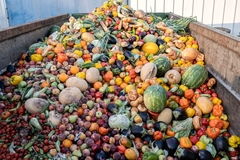FiE live: Olam food ingredients leverages AI and industry partnerships to drive growth
30 Nov 2023 --- Olam food ingredients (ofi) is actively embracing innovative approaches and partnerships to cater to the growing demand for natural, traceable and sustainable ingredients. We speak to Defne Saral, SVP of sales at ofi, at Food Ingredients Europe (FiE) in Frankfurt, Germany, about viable pathways for the future of the F&B ingredients sector.
“Collaboration is a great word. First of all, it’s collaborating internally about our own ingredients together and how they can combine to make something interesting like we have a vegan cappuccino,” she tells Food Ingredients First.
“Externally, collaboration is about working with customers and different stakeholders. We do a lot of work with NGOs on the ground and with aid agencies. What is really needed in the food industry is to become more sustainable.”
Tackling deforestation through high-tech innovation
New EU deforestation regulation coming into effect at the end of 2024 will help to create a level playing field and strengthen the industry’s efforts to tackle environmental issues such as deforestation and climate change.
“It is a framework and a structure for companies to import products into the EU that are deforestation-free. We’re working with our customers to make sure that we meet their needs for compliance,” says Defne.

“People want a healthy future, meaning not taking away from future generations how that food was made — so we want regenerative agriculture to be in place.”
According to the company, Ofi has been focusing on reducing deforestation in cocoa and coffee smallholder supply chains through promoting agroforestry and advancing sustainability programs.
Its Carbon Scenario Planner, which recently won the Sustainability Innovation Award, is integrated into its At Source sustainability management system to protect the environment.
 Sustainability Innovation Award recognizes a company for a measurable supply system that demonstrates environmental, economic or socially sustainable practices in the F&B industry. “From the satellite maps, you can see where the farm sits and if it’s close to an area that is sensitive, maybe a natural reserve,” explains Defne.
Sustainability Innovation Award recognizes a company for a measurable supply system that demonstrates environmental, economic or socially sustainable practices in the F&B industry. “From the satellite maps, you can see where the farm sits and if it’s close to an area that is sensitive, maybe a natural reserve,” explains Defne.
She also tells us that Ofi measures various key performance indicators through its team’s work, a carbon calculator and deforestation mapping.
Plant-based food and protein
In 2023, plant-based products continued to be a key focus, and this trend is expected to persist with a new perspective. The evolving consumer mindset generally views plant-based as complementary to dairy instead of viewing it as a zero-sum game between the two.
“People are curious about plant-based products, and we’ve seen in our research that a lot of consumers are open to trying plant-based foods,” says Defne.
“Some 65% of people are open to trying plant-based foods, but it doesn’t mean that they want to switch to it entirely. They want it to be complementary, so they’re looking for new tastes that might be a sustainability angle that they want to have or perhaps a nutritional angle.”
At FiE, Defne is observing a high focus on plant-based products and proteins. “If people are looking for fortification, getting enough protein in the morning and evening, then those two trends aren’t going away anytime soon,” she comments.
“Nuts are great for protein and good fats. We’re seeing it being included in many more products. We did some consumer research in 2022 on plant-based foods and realized that consumers have a positive attribution for nuts versus soy or pea, which would be the other plant proteins that are used.”
AI as a catalyst for innovation Many consumers are keen to experience unusual flavors from across the world and becoming more adventurous with their flavor choice (Image credit: ofi).
Many consumers are keen to experience unusual flavors from across the world and becoming more adventurous with their flavor choice (Image credit: ofi).
At FiE, ofi has showcased how AI-generated research predicts a growing fusion of Eastern and Western flavors across various categories like confectionery, bakery and snacks. AI is seen as a tool to amplify the capabilities of ofi’s innovation teams, enabling them to stay ahead of changing consumer trends.
Amid a whirlwind of culinary evolution, TikTok stands out as a big player in shaping food trends since 2021, accumulating billions of views and permeating various social media platforms with different West-East fusion food like Poprock tanghulu and taco wonton.
Ofi recently conducted research using predictive analytics to scan big data for budding cocoa trends before they hit the mainstream.
The company uncovered the emergence of Asian tastes such as dragon fruit, sesame, yuzu, lychee and matcha, which are gaining traction in the US and Europe. Conversely, in South Asian countries like Indonesia and India, Western flavors like butterscotch, marshmallow and salted caramel are experiencing a surge in popularity.
By Sichong Wang, with additional reporting by Missy Green at FiE in Frankfurt, Germany
















